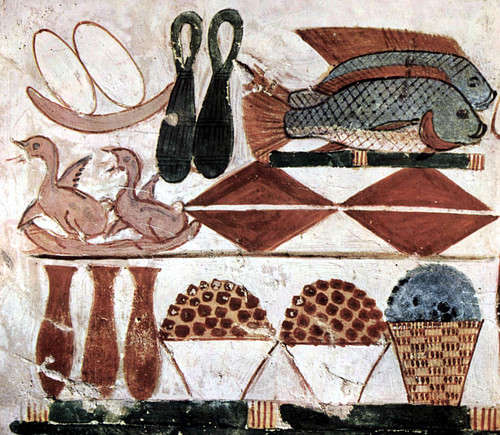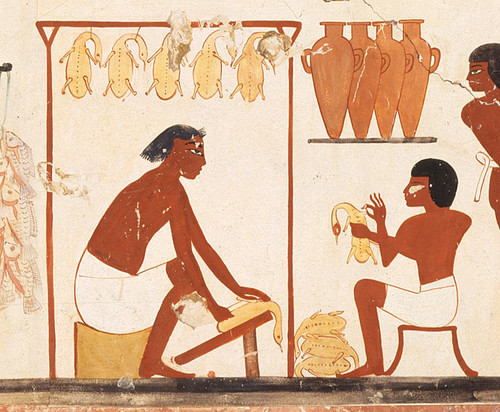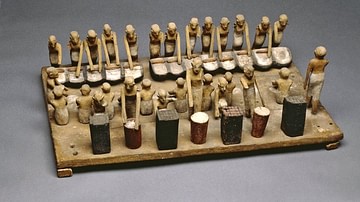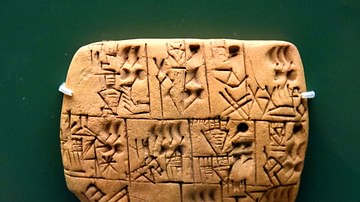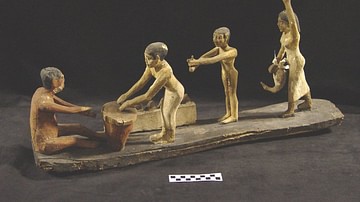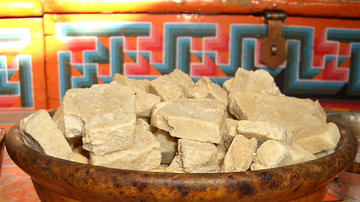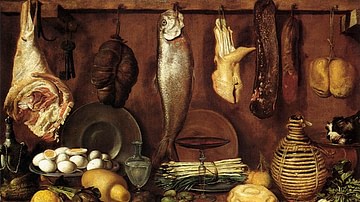Food and drink in ancient Egypt relied on barley and wheat, the primary crops cultivated along the Nile. The Egyptian diet was based on bread, beer, and vegetables. Meat was expensive and only rarely eaten. The majority of people ate fairly basic meals, while the upper classes consumed more exotic and varied dishes.
Bread & Porridge
Breads and porridges were the base of the Egyptian diet. They were both typically made with barley or emmer wheat, the two staple crops of Egypt. Grain was ground by hand with stone querns to produce flour. Despite efforts to prevent it, grit and sand often found its way into flour while it was being processed and transported. Many mummies have teeth worn down from years of eating gritty bread.
Egyptian cuisine in fact allowed for the preparation of bread in all possible shapes: flat, conical, spherical, sometimes molded into shapes of objects or animals, and extremely varied ingredients could be added to the dough for sweetening or aroma: lupine seeds, coriander, a decoction of figs, and poppy or ryegrass seeds. (Tallet, 320)
The most common style of bread was a dense flatbread made with flour, salt, and water. The dough was typically formed into round or triangular shapes, but it could also be shaped into human or animal figures. This could be baked on a stone inside an oven, on the floor of the oven itself, or even buried in hot embers.
Because bread was so important, many different varieties were invented. Some types of bread included fats, oils, eggs, or dairy in addition to the basic ingredients of flour and water. Leavening was used to create fluffier loaves. Special types of ovens and pans were used to bake bread of different shapes and consistencies. Bread was sometimes topped with seeds, seasonings or nuts before baking.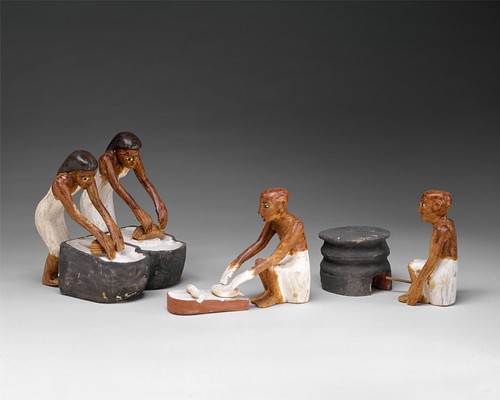
Fruits & Vegetables
Fruits and vegetables were a significant component of the Egyptian diet. Lentils, beans, and peas added both fiber and protein to porridges and soups. Garden vegetables like onions, lettuce, cucumbers, garlic, and radishes were staples of Egyptian meals. Aquatic plants like sedges, including papyrus reeds, were also commonly harvested as food. Egyptians enjoyed both eating vegetables raw and roasting or boiling them.
Since the Nile has a gentle current, carries down a great quantity of all kinds of earth, and, furthermore, gathers in stagnant pools in low places, marshes are formed which abound in every kind of plant. For tubers of every flavour grow in them and fruits and vegetables which grow on stalks, of a nature peculiar to the country, supplying an abundance sufficient to render the poor and the sick among the inhabitants self-sustaining. (Diodorus Siculus, 1.34.3)
Fruit was used as an ingredient or eaten on its own as a dessert. Figs, dates, grapes, melons, and berries were served as snacks and desserts. Olives and capers were also eaten although they were not as central to the Egyptian diet as they were in Greek and Roman culture. Apples were probably introduced from Palestine, and the Egyptian word for apple, depeh, is a Semitic loanword.
Beverages
Barley beer was the national beverage, often brewed at home. It was made by fermenting bread and crushed barley in a container of water. Once the fermentation was complete, it was strained through a filter and jarred. The resulting product was thick and nutritious. It generally had a low alcohol content, which meant that it was suitable for all-day consumption.
Beer in ancient Egypt was categorized by colour, denoting its alcohol content. Red beer was lighter and less alcoholic, while black beer was stronger. Fruits and spices were sometimes added to the mix to improve its flavour. This method of beer production is still used in modern-day Egypt and Sudan. Grapes did not grow as easily in Egypt as in other parts of the Mediterranean, so wine was only produced in small quantities for the wealthy elite. The earliest evidence for winemaking in Egypt dates back to 3200 BCE, before the beginning of the Early Dynastic Period. Some wines were imported from Greece and Mesopotamia.
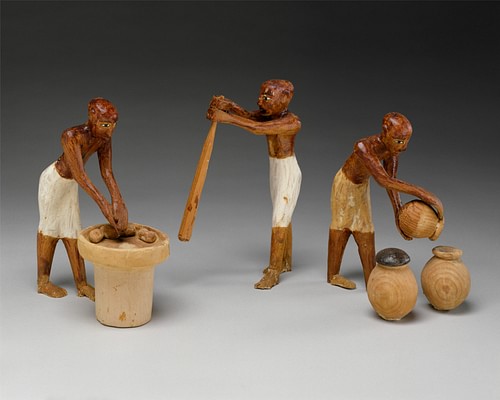
Egyptian wine was produced by fermenting grapes in clay jars, which were perforated with small holes to allow gases created by fermentation to escape. The finished product was labeled with clay seals describing the wine's provenance, quality, and year. Wines were also sometimes made from dates, figs, pomegranates, or palm sap. A strong wine liquor called shedeh was also produced. It had a red colour and high alcohol content, but little is known about its preparation.
Poultry & Dairy
Dairy, eggs, and poultry were the primary sources of protein, besides legumes. Farmers raised cows, goats, and sheep for milk, butter, and cream. Goats and sheep were cheaper to raise than cattle, making them preferable to poorer farmers.
Cheesemaking was probably introduced to Egypt during the Neolithic period, and a cheesemaking industry certainly existed by the Early Dynastic Period in Egypt. The cheesemaking industry in ancient Egypt became more specialized over time, as different types of hard and soft cheeses were created. The oldest discovered solid cheese sample was found in the tomb of Ptahmes, mayor of Memphis during the 19th Dynasty.
Birds, both wild and domesticated, were a primary source of meat and eggs in ancient Egypt. Geese, cranes, and ducks were force-fed to fatten them before cooking. Pigeons and doves were considered a delicacy and were used as food offerings. The ancient Egyptians also ate the meat and eggs of pelicans and ostriches. Ostrich eggs, due to their large size and excellent flavour, were held in particularly high regard.
There is more limited evidence for chickens, originally from South Asia, in ancient Egypt. An Egyptian ostracon from c. 1350 BCE depicts a red junglefowl, the wild ancestor of chickens. Chickens and chicken eggs were imported, but they did not begin to be farmed in large numbers until the Ptolemaic period.
Meat & Seafood
Many domesticated livestock animals were raised in ancient Egypt. These included cows, oxen, goats, donkeys, sheep, antelope and pigs. However, meat was only eaten rarely because it was more economically viable to use livestock as draft animals or dairy producers. Occasions on which meat was eaten included feasts and sacrifices when animals were slaughtered as offerings to the gods.
Some ancient sources, including the Greek historian Herodotus (5th century BCE), claimed that the ancient Egyptians had a religious taboo against pigs. Archaeological evidence shows that pork was not popular, but it was eaten, especially by the lower classes. Some modern historians have suggested that this taboo may have only applied to certain groups, such as priests or the upper classes. The origins of the pork taboo may be related to the perception of pigs as unclean or low-status animals. Wild game was also eaten in ancient Egypt. Hunting was associated with the upper classes, whose tombs were often decorated with hunting scenes. Gazelles, antelopes, and hippopotamuses provided tasty meat and could be found in the marshes and grasslands of Egypt. Game birds like ducks, geese, and quails were also abundant.
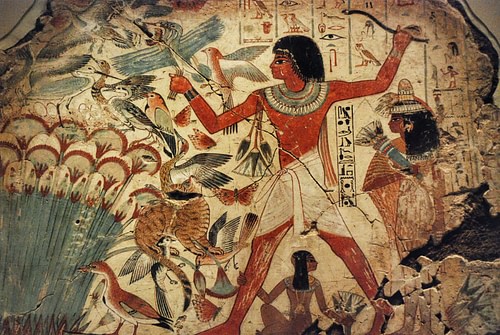
Freshwater fish, like carp, catfish, Nile salmon, and eels could be found in rivers and lakes. Coastal fish like grey mullet were also popular. Smoking and drying fish helped to preserve it in Egypt's hot climate. The elephantfish, known as medjed in Egyptian and oxyrhyncus (lit. "sharp-nosed fish") in Greek, was considered sacred. The city of Per-Medjed or Oxyrhyncus was named after it. The Egyptians typically used nets or rods to capture fish.
Sweets & Desserts
The Egyptians ate a variety of sweets, including cakes, pastries, and confections. These often contained chopped fruits, nuts, or sweet syrups. Honey was one of the primary sweeteners in the ancient world, as sugar cane had not yet been imported from South Asia. Because honey was expensive, dates and carob beans were more often used as sweeteners. Date flour was so commonly used in confectionery that pastry chefs were called "workers in dates".
The tiger nut, a type of sedge with a sweet-tasting root, was widely used in sweets. The tomb of Rekhmire, a vizier from the 18th dynasty, is decorated with Egyptian art portraying the making of tiger nut cakes. These cakes may have been served with a syrup of dates and honey, which is also shown being prepared on the tomb walls.
The 'flour' produced by pounding tiger nuts in the primitive way shown in Rekhmire's tomb would be coarse even after sieving, with a texture similar to roughly ground almonds. ... The nature of the liquid added to mix the dough is uncertain, as the inscription is damaged, but it could be water, milk, oil, or melted fat or a combination of any of these. ... Although no kneading is shown in the Rekhmire scene, it is clear that the mixture results in a malleable dough.
(Wilson, 216)
Cooking Methods
Little is known about ancient Egyptian recipes, as there are no known examples of Egyptian cookbooks. Egyptologists have reconstructed Egyptian food based on art, descriptions of food production and residues of plant and animal remains from archaeological sites. Simple methods of preparation like soups, stews, and casseroles were most popular. Meat was often braised or boiled in large pots, and less commonly roasted or fried. Birds and other small animals were often stuffed with spices and chopped vegetables. Baked hedgehogs were covered in clay which hardened during baking; when the clay shell was removed, the spiny hairs of the hedgehog were pulled out with it.
The Egyptians produced many different spices and seasonings used to enhance the flavour of food. Herbs like dill, parsley, thyme, cumin, fenugreek, oregano and mint were grown. Other additives like mustard, palm nuts, and lotus flowers added vibrancy to dishes. Vegetable oil and animal fats were both used for cooking. Balsam, linseed, sesame, and castor were all used for oil.
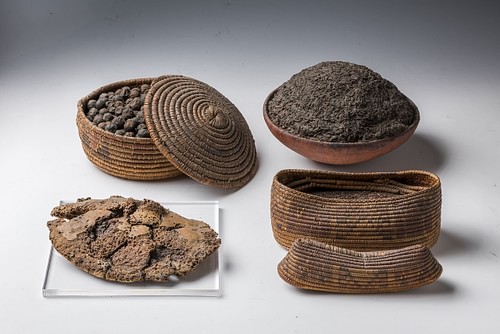
Kitchenware was usually made of stone or earthenware. These materials made sturdy pots and storage vessels but could also be sharpened into effective utensils. Some ancient flint knives found by archaeologists in Egypt still have a sharp edge today. In upper-class households, cooks also used bronze or copper cauldrons and kitchenware. Hearths were generally placed outside or on an upper floor to prevent heat, smoke, and food smells from pervading the house.
Food was commonly preserved by drying, pickling, or salting it. Sun-drying thin strips of food was an easy and effective way of preserving it. Meat was also packed in brine and salt to preserve. Jarred, salted fish was especially popular in the ancient world. The Egyptians probably invented caviar, which is made by packing roe – or fish eggs – in salt. The Egyptians used grey mullet for this. Meat and other foods were also preserved by slow-cooking them in fat to produce confit. This was then packed into sealed jars. Birds, pigs, and hyenas were force-fed to help fatten them, possibly for this purpose.
Meals
People usually ate seated on stools or the floor around a low table. Diners would scoop food from communal dishes, mainly bowls and reed mats, using spoons or their hands. Simple clay cups and wooden utensils were common, while wealthy households had finely crafted dining ware made of metal, glass, and porcelain. While eating, they cleaned their hands with napkins or water. In the New Kingdom of Egypt, it became fashionable for upper-class diners to sit at taller tables in high-backed chairs.
A simple breakfast of bread, beer, and green onions was typical. This was sufficient to give most people the energy they needed to perform manual labour such as farming or building. Workers could purchase food from bakeries and taverns, which were often conveniently close to work sites. After coming home from work in the evening, they would sit down to a heavier meal. This might include beer, stewed vegetables, eggs, and bread.
In a Saqqara tomb of the Second Dynasty, a full meal was found that had been laid out for an unnamed noble. It included pottery and alabaster dishes containing a porridge of ground barley, a spit-roasted quail, two cooked lamb's kidneys, pigeon casserole, stewed fish, barbecued beef ribs, triangular loaves of bread made from ground emmer, small round cakes, a dish of stewed figs, a plate of sidder berries, and cheese, all accompanied by jars that had once contained wine and beer. (Alcock, 182)
Wealthier households, who had a staff of servants to prepare food, ate more elaborate meals. The upper class might stop for two or three meals per day, with evening meals being heavier. These banquets could be long affairs, involving multiple courses and complex dishes. During festivals, poorer people would also have access to more expensive banquet food.
Changes in the Greco-Roman Period
The conquest of Egypt by Alexander the Great (r. 336-323 BCE) in 332 BCE brought Greek culinary influences. During the Ptolemaic Dynasty, thousands of Greeks immigrated to Egypt. They brought with them new types of kitchenware, grills, and ovens, which were better suited to their own style of cooking. Greeks preferred wheat to barley and did not share the Egyptian disdain for pork. Mediterranean crops like pears, walnuts, peaches, apricots, and plums were introduced to Egypt as the economy of Ptolemaic Egypt changed. Prepared specialty foods like wine and cheeses were also imported from Greece.
Wine also became a much more important product in the Ptolemaic period. Vineyards were planted throughout Egypt, sometimes with imported grapevines brought from Greece. Lake Mareotis, near Alexandria, became famous for the high-quality white wine produced on its shores. The vast majority of Egyptian wine was considered of low quality by writers from cultures who placed high importance on wine, such as Greece and Rome.
The capital city of Alexandria developed a unique cuisine influenced by its cosmopolitan urban culture. After 30 BCE, Roman Egypt absorbed Italian influences. Because it was located on the coast, seafood was a signature part of ancient Alexandrian cuisine. Hellenistic Egyptian cuisine is described by the writer Athenaeus (3rd century CE), who came from the port city of Naukratis, Egypt. In his book The Learned Banqueters, he discusses recipes for dishes like roasted shark, stuffed cuttlefish, and breaded fish.

